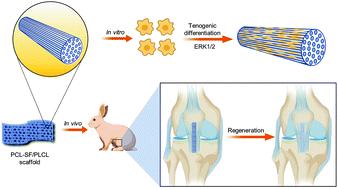当前位置:
X-MOL 学术
›
Biomater. Sci.
›
论文详情
Our official English website, www.x-mol.net, welcomes your
feedback! (Note: you will need to create a separate account there.)
A novel knitted scaffold made of microfiber/nanofiber core-sheath yarns for tendon tissue engineering.
Biomaterials Science ( IF 5.8 ) Pub Date : 2020-07-02 , DOI: 10.1039/d0bm00816h Jiangyu Cai 1 , Xianrui Xie 2 , Dandan Li 2 , Liren Wang 1 , Jia Jiang 1 , Xiumei Mo 2 , Jinzhong Zhao 1
Biomaterials Science ( IF 5.8 ) Pub Date : 2020-07-02 , DOI: 10.1039/d0bm00816h Jiangyu Cai 1 , Xianrui Xie 2 , Dandan Li 2 , Liren Wang 1 , Jia Jiang 1 , Xiumei Mo 2 , Jinzhong Zhao 1
Affiliation

|
Tendon injury is common in sports and other rigorous activities, which may result in dysfunction and disability. Recently, scaffolds with a knitted structure have been widely applied for tendon tissue engineering. The purpose of this study was to fabricate a novel knitted tendon scaffold made of microfiber/nanofiber core–sheath yarns and evaluate the biocompatibility and the effect of tenogenic differentiation and tendon tissue regeneration in vitro and in vivo. Poly(ε-caprolactone) (PCL) microfibers, PCL microfibers–PCL nanofibers (PCL–PCL) and PCL microfiber-silk fibroin/poly(L-lactic acid-co-ε-caprolactone) nanofiber (SF/PLCL) core–sheath yarns were fabricated and then knitted with an automatic knitting machine to produce PCL, PCL–PCL and PCL-SF/PLCL fabric scaffolds. The characterization of the scaffolds was performed by using scanning electron microscopy, attenuated total reflectance Fourier transform infrared spectroscopy and an universal mechanical instrument. The in vitro experiment showed that rabbit bone marrow stem cells seeded on the scaffolds exhibited an elongated morphology and proliferated better in the PCL-SF/PLCL group, as compared to the PCL and PCL–PCL groups. Moreover, the PCL-SF/PLCL scaffold promoted the tenogenic differentiation of the cells for the highest expression levels of the tendon-related genes through down-regulating p-ERK1/2 expression among the three groups. Furthermore, the in vivo study in a rabbit patellar defect model demonstrated that the PCL-SF/PLCL scaffold could enhance the tissue regeneration and remodeling process as indicated by the better structural and biomechanical properties according to the results of histology, immunohistochemistry, transmission electron microscope examination and biomechanical tests. Therefore, the PCL-SF/PLCL scaffold is proved to be a promising biomaterial for tendon tissue engineering and a potential candidate for clinical treatment of tendon injury in the future.
中文翻译:

一种由超细纤维/纳米纤维芯鞘纱制成的新型针织支架,用于腱组织工程。
肌腱损伤在体育运动和其他严格的活动中很常见,可能会导致功能障碍和残疾。近来,具有编织结构的支架已被广泛地用于肌腱组织工程。这项研究的目的是制造一种由超细纤维/纳米纤维芯-鞘纱制成的新型针织肌腱支架,并在体外和体内评估其生物相容性以及肌腱分化和肌腱组织再生的效果。聚(ε -己内酯)(PCL)微纤维,微纤维PCL-PCL纳米纤维(PCL-PCL)和PCL微纤维的丝素蛋白/聚(大号-乳酸酸共先制备-ε-己内酯)纳米纤维(SF / PLCL)芯鞘皮纱,然后使用自动编织机进行编织,以生产PCL,PCL-PCL和PCL-SF / PLCL织物支架。通过使用扫描电子显微镜,衰减的全反射傅里叶变换红外光谱和通用机械仪器对支架进行表征。在体外实验表明,与PCL和PCL–PCL组相比,在PCL-SF / PLCL组中,接种在支架上的兔骨髓干细胞表现出拉长的形态并增殖得更好。此外,PCL-SF / PLCL支架通过下调三组之间的p-ERK1 / 2表达,促进了肌腱相关基因的最高表达水平的细胞腱分化。此外,体内对兔pa骨缺损模型的研究表明,根据组织学,免疫组织化学,透射电子显微镜检查和生物力学测试的结果,PCL-SF / PLCL支架可以增强组织再生和重塑过程,表现出更好的结构和生物力学特性。因此,事实证明,PCL-SF / PLCL支架是用于腱组织工程的有前途的生物材料,并且是将来临床治疗腱损伤的潜在候选者。
更新日期:2020-08-11
中文翻译:

一种由超细纤维/纳米纤维芯鞘纱制成的新型针织支架,用于腱组织工程。
肌腱损伤在体育运动和其他严格的活动中很常见,可能会导致功能障碍和残疾。近来,具有编织结构的支架已被广泛地用于肌腱组织工程。这项研究的目的是制造一种由超细纤维/纳米纤维芯-鞘纱制成的新型针织肌腱支架,并在体外和体内评估其生物相容性以及肌腱分化和肌腱组织再生的效果。聚(ε -己内酯)(PCL)微纤维,微纤维PCL-PCL纳米纤维(PCL-PCL)和PCL微纤维的丝素蛋白/聚(大号-乳酸酸共先制备-ε-己内酯)纳米纤维(SF / PLCL)芯鞘皮纱,然后使用自动编织机进行编织,以生产PCL,PCL-PCL和PCL-SF / PLCL织物支架。通过使用扫描电子显微镜,衰减的全反射傅里叶变换红外光谱和通用机械仪器对支架进行表征。在体外实验表明,与PCL和PCL–PCL组相比,在PCL-SF / PLCL组中,接种在支架上的兔骨髓干细胞表现出拉长的形态并增殖得更好。此外,PCL-SF / PLCL支架通过下调三组之间的p-ERK1 / 2表达,促进了肌腱相关基因的最高表达水平的细胞腱分化。此外,体内对兔pa骨缺损模型的研究表明,根据组织学,免疫组织化学,透射电子显微镜检查和生物力学测试的结果,PCL-SF / PLCL支架可以增强组织再生和重塑过程,表现出更好的结构和生物力学特性。因此,事实证明,PCL-SF / PLCL支架是用于腱组织工程的有前途的生物材料,并且是将来临床治疗腱损伤的潜在候选者。











































 京公网安备 11010802027423号
京公网安备 11010802027423号